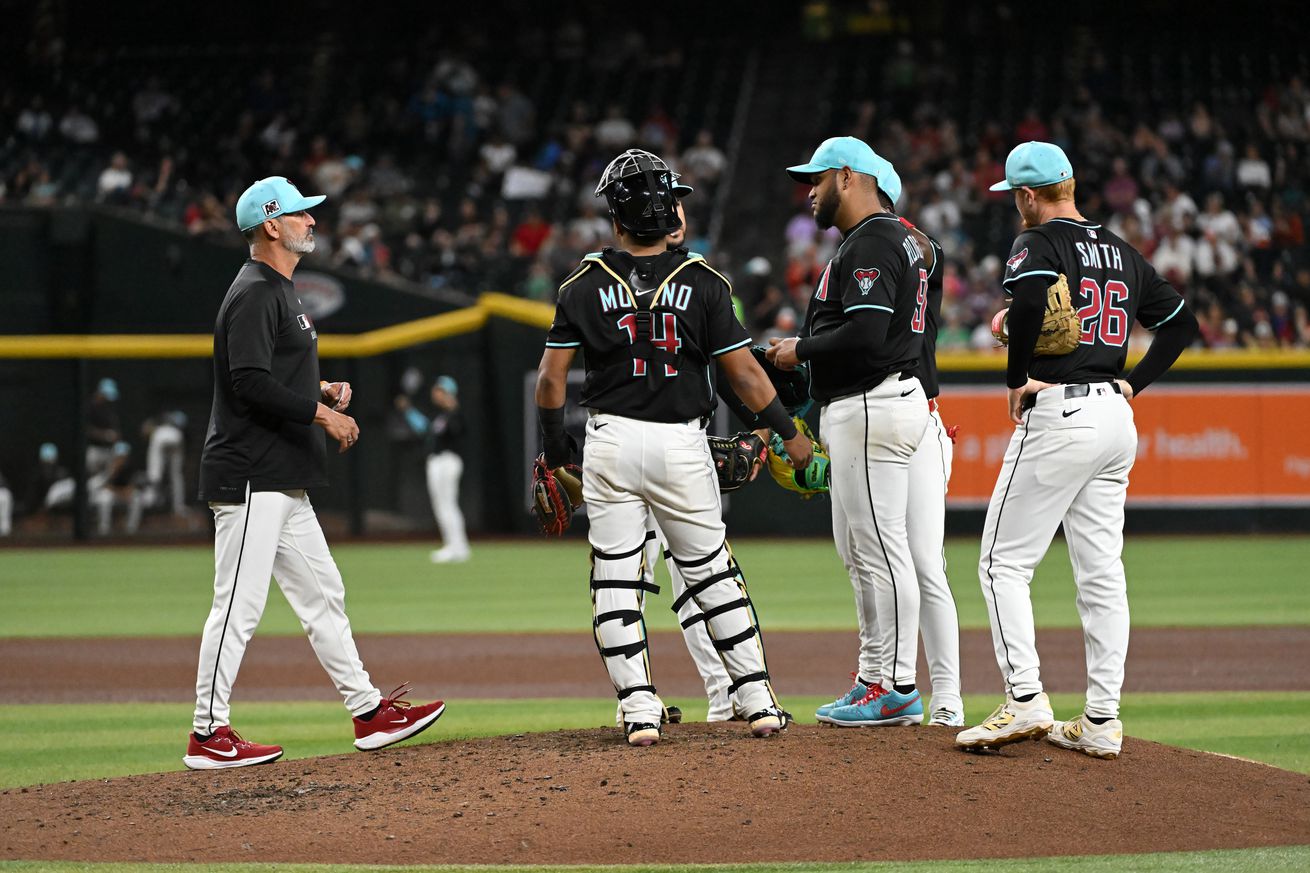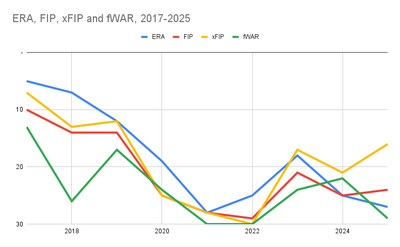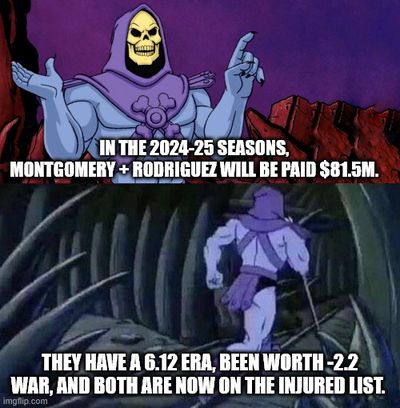
And we thought this year might be different…
Since the Diamondbacks lost A.J. Puk on April 17, it feels like every week this year has had a bullpen meltdown of one kind or another. Up until that point, things had actually been going very well for the Arizona relief corps. Over the first nineteen games, they had an ERA of 3.48 (an improvement of almost a whole run on 2024’s figure of 4.41), a 4-0 record, and most impressively of all, were a perfect 17-for-17 in save opportunities, with six saves and eleven holds. We didn’t know it at the time, but that would be Puk’s last stand, and was as good as it would get for the Arizona bullpen. Three weeks into the season, the baseball gods were about to go all Final Destination on our relievers.
Things went from sixty to zero pretty damn fast. It didn’t take long for things to fall apart. The day after Puk saved the series finale in Miami, the bullpen allowed eleven earned runs in two innings against the Cubs at Wrigley Field. To be fair, it was the largely B-arms of Ryne Nelson, Bryce Jarvis and Joe Mantiply who were responsible, but even by the standard of mop-up relievers, this was something special. The following day, Puk went on the Injured List and… Well, things fell apart. Over the thirty subsequent games, going into yesterday’s finale at Dodger Stadium, the Arizona bullpen had a record of 3-8 with a 6.45 ERA, and ten blown saves.
Sometimes, games have been lost with a bang – the Cubs one, the Dodgers scoring six in the ninth. or the lowly Rockies battering Jalen Beeks, Ryan Thomson and Kendall Graveman around for eight earned runs in their 2.1 innings of work. Sometimes, it’s been more of a whimper, like Tuesday night, where Shelby Miller pitched for the third night in a row, allowed one hit and still took the L [the two walks and hit batter proved to be pivotal]. But the end result has been the same. A bullpen where, on any given night, Torey Lovullo has to decide between over-taxing the more reliable arms, or throwing onto the mound pitchers whose performance is unreliable.
There’s no doubt that the loss of Puk, followed at the end of the month by Justin Martinez, has been a factor. The pair were intended to be co-closers, and as noted, it worked very nicely at the beginning of the year But after Puk went down, Martinez seemed to fall apart in sympathy. He posted a K:BB of 1:5 across four outings, showing diminished velocity and no control, before following Puk onto the IL. There wasn’t immediately a Plan C as in Closer: between April 30th and May 10th, the D-backs got five saves – from five different pitchers. They finally settled on Shelby Miller. He has a 5.63 ERA this month, in line with his FIP (5.59), but still feels like the best of the available options.
Here’s where the D-backs’ bullpen stands and ranks across various metrics, as we enjoy the off-day before going to the pitching hell-hole which is Coors Field. Last year’s figures and ranks are in brackets.
- ERA: 5.28, 27th (4.41, 25th)
- FIP: 4.45, 24th (4.19, 25th)
- xFIP: 4.05, 16th (4.13, 21st)
- fWAR: -0.8, 29th (2.3, 22nd)
This continues a trend we’ve noted before. The last time the Diamondbacks finished in the top half of baseball for ANY of those categories was 2019. As the graph below shows, approaching the one-third mark this season, it’s not looking good for 2025.

It was notable this winter that they did not spend much money on relief help. Nobody in the bullpen is getting paid even $3 million this year, with Ryan Thompson’s $2,965,000 the highest amount for an Arizona reliever. Additions came in the form of very low-cost deals: Jalen Beeks, Kendall Graveman, Shelby Miller and Scott McGough are costing only about $4.25 million between them (though in some cases, incentives may increase the final cost). That’s half the current bullpen. Add Thompson and Kevin Ginkel, plus the league-minimum contracts of Juan Morillo and Christian Montes de Oca, and right now, the entire D-backs relief corps is costing less than Josh Naylor.
Should they have spent more? A couple of weeks ago, Jack dove into the bullpen and noted, “There were a number of high-leverage relievers available on the free agent market, but it became apparent the D-backs were not able to compete for any of these pitchers.” He contrasted the D-backs approach to that of the Dodgers, who gave eight-figure contracts to Tanner Scott, Kirby Yates and Blake Treinen. That trio alone are getting paid more than $34 million this year, according to Spotrac. However, Yates (hamstring) and Treinen (forearm) are both on the injured list, and while Scott has been good, he blew the save on Tuesday. Combined, they have been worth just 0.4 bWAR so far, less than Beeks.
It’s also reasonable to point out that the D-backs’ experiences where the results from paying for relief help have not been encouraging. Here’s a list of some pitchers in that category over the past few seasons, who all earned more than almost anyone in this year’s bullpen, and failed to deliver much:
- 2024, Paul Sewald – $7.375m, 0.2 bWAR, 98 ERA+
- 2023-24, Scott McGough – $5.5m, -1.0 bWAR, 78 ERA+
- 2023, Andrew Chafin – $6.25m, 0.1 bWAR, 106 ERA+
- 2022-23, Mark Melancon – $12m, -0.8 bWAR, 87 ERA+
- 2022, Ian Kennedy – $4.75m, -1.1 bWAR, 75 ERA+
- 2021, Joakim Soria – $3.5m, 0.3 bWAR, 99 ERA+
Admittedly, this may not be just a Hazen problem. Long-term fans – and you probably need to be middle-aged – will remember Matt Mantei. He was signed to a $22 million, four-year contract in January 2001, the equivalent of well over $50 million nowadays. It became one of Arizona’s worst ever.

On the other hand, there’s an increasing case to be made that Mike Hazen has a pitching problem. I refer you to the above meme. Throw in Madison Bumgarner, and you understand nervousness about Corbin Burnes’ early struggles. And if free-agency has been shaky, the entire amateur pitcher draft, sign and development system has been almost completely useless. The best pitcher for Arizona drafted under Hazen is Ryne Nelson, who is now in his fourth season, been worth a total of about three wins and has a career ERA+ of 93. The only pitcher in our top ten prospects, Yilber Diaz, seems to have fallen apart this year, and has more walks than innings pitched. You do not want to look at his last box-score, trust me.
There have been some successes – Merrill Kelly is perhaps the most obvious. But the bottom line is this: over the entirety of the Hazen era from 2017-2025, the Diamondbacks rank 26th by fWAR for pitching, ahead only of Baltimore, Oakland, Colorado and Miami. That’s not general company with which any successful franchise would want to be classed. It all means that even when the team scores forty more runs than anyone else in the majors, as last year, they still don’t make the post-season, because the pitching was simply so bad. Can this be fixed without a complete overhaul of approach and personnel? Every year which passes with further issues, seems to indicate that may simply not be possible.